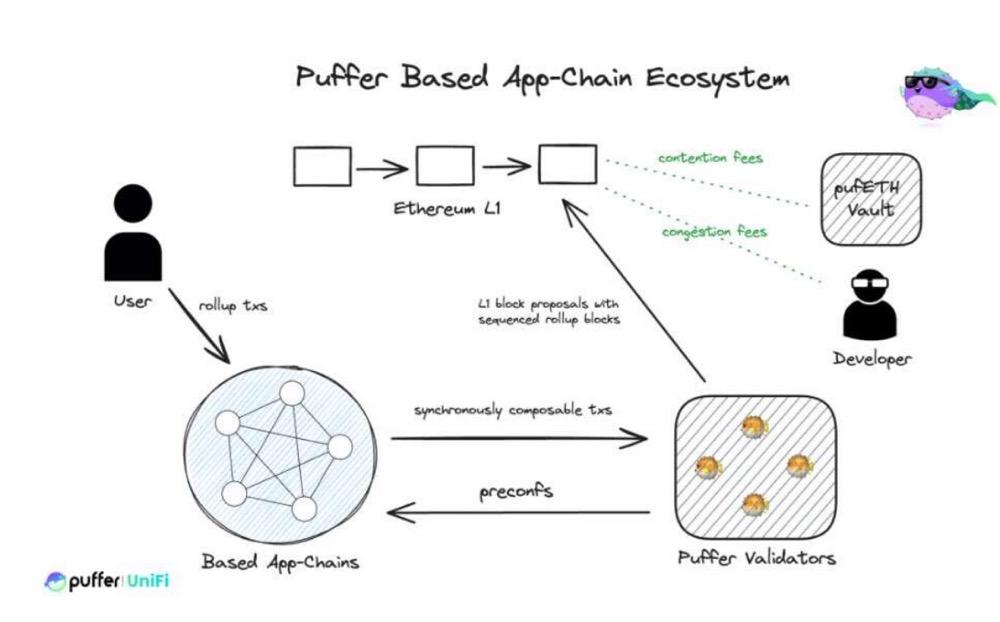With the rapid expansion of the Ethereum Rollup ecosystem, problems such as liquidity fragmentation and inefficient cross-chain interactions have become increasingly prominent. Based Rollup, which aims to return transaction sorting rights to the Ethereum mainnet and solve the Rollup "island effect", has been widely regarded as a new path to push the Ethereum ecosystem from "fragmented competition" to "collaborative win-win".
In this context, as a pioneer in the Based Rollup field, Puffer UniFi, launched by Puffer, provides developers with a decentralized and highly compatible Based Rollup solution by integrating the re-staking node service (LRT) and pre-confirmation service (UniFi AVS).
As early as November 7, 2024, Puffer UniFi officially launched the UniFi internal testing service for developers, and will soon launch the second phase of the UniFi test network public version. This also marks that the Ethereum ecosystem is gradually moving from fragmentation to interconnection and moving towards a new stage of more coordinated development.

Based Rollup: Ethereum's self-correction technological leap
L2BEAT data shows that there are currently more than 50 Ethereum Rollup-type L2s, making it one of the most prosperous Ethereum tracks. However, with the expansion of the number of L2s, the liquidity fragmentation problem caused by independent sequencers and cross-chain delays between chains has become increasingly serious.
For example, it is impossible to achieve seamless interaction between funds and contracts between different Rollups. Developers must bet on one or more L2s to acquire customers, and users frequently transfer assets dynamically between multiple L2s. This process not only increases the user experience and complexity of the development process, but also greatly limits capital efficiency and seriously restricts the overall development of the Ethereum ecosystem.
Ultimately, the core factor that separates L2 from each other is that each L2 has its own centralized sequencer. Therefore, Based Rollup characterized by "L1-Sequenced" has become a new solution:
The power of transaction sorting is returned to the Ethereum mainnet. All Rollup application chains share this decentralized sorter infrastructure, and all transactions are sorted and packaged through the Ethereum mainnet.
Therefore, the core advantage of Based Rollup lies in its complete decentralization and inheritance of the activity of the Ethereum mainnet - this means that funds can be withdrawn directly from Rollup, and since they are all sorted through the mainnet, smart contracts on different Rollups can interact directly and seamlessly. At the same time, since they are all sorted through the mainnet, the island effect of funds and user groups is fundamentally eliminated.
From this perspective, Based Rollup is also an important step in tearing down the high wall of Ethereum's L2. It is also expected to restore the interoperability and composability between L2 and L2, and L2 and L1. Users will experience seamless interaction like a single chain, developers can build a highly interoperable application ecosystem, and Ethereum's capital efficiency and network effects can be maximized.
As an Ethereum decentralized infrastructure provider, Puffer has also launched its own Based Rollup development stack based on UniFi AVS. On the one hand, it aggregates and re-stakes node resources through Puffer LRT, lowers the threshold for node participation, and provides a decentralized sorter cluster. On the other hand, UniFi AVS can also achieve millisecond-level transaction confirmation delays through TEE hardware acceleration.
In particular, Puffer uses its TEE-Multiprover technology to achieve Atomic Composability with the Ethereum mainnet. With low latency at the millisecond level, all cross-L2-L1 operations can be run through a transaction, ensuring either complete success or complete failure.
For example, users can call contracts on multiple Rollups in the same transaction to complete complex cross-chain financial operations while avoiding the uncertainty of intermediate states. This unlocks use cases such as efficient arbitrage, flash loan refinancing, and instant liquidation, bringing direct economic benefits to developers and users.
Puffer UniFi's Ecosystem Reconstruction Value
From a product perspective, re-staking is just the starting point for Puffer. Puffer’s ultimate mission is to break the fragmentation of the Ethereum ecosystem through the Based Rollup architecture. Puffer LRT and UniFi AVS provide UniFi with complete tools and technical support - L1 verification/sorting/re-staking nodes, pre-confirmation mechanism, etc.
On this basis, Puffer deeply integrated Puffer LRT and UniFi AVS into the Based Rollup development stack, enabling developers to quickly build Based Rollup application chains with strong interoperability and high decentralization. This not only provides an effective path to solve the existing Rollup L2 bottleneck, but also opens up a new collaboration and growth model for developers and project parties.
First of all, the application chain architecture based on Puffer UniFi abandons the reliance on traditional centralized sequencers, greatly reducing the operational burden and technical costs of developers:
● Simplified on-chain management: No need to maintain complex sorter infrastructure, developers can focus more on application development;
● Lower the entry threshold: Start-up projects and small and medium-sized teams can quickly join the ecosystem and build their own application chains, thereby further stimulating the innovative vitality of the Ethereum ecosystem;

Secondly, Puffer UniFi allows developers to directly capture part of the value generated by transaction fees after deploying their own application chains (Congestion Fees generated by transactions in the figure above), thereby building a new incentive mechanism for the ecosystem.
After all, these profits are a private reserve, which can be used to subsidize users and liquidity incentives, and can also be used as a source of income for the project itself, further supporting marketing, traffic and product development within the ecosystem. This economic autonomy enables project parties to more flexibly balance ecological expansion and their own profit goals, forming a virtuous circle.
In this ecosystem, Rollups are no longer in a zero-sum competition, but rather achieve win-win results through shared resources. This means that latecomers can also leverage the existing mature user base to quickly open up promotion opportunities at low cost. At the same time, this economic autonomy is also expected to inspire individual project owners/developers to give full play to their subjective initiative, forming a spontaneous ecosystem based on UniFi to build applications and achieve large-scale scene implementation and adoption breakthroughs.
Conclusion
Based Rollup is a dynamic rebalance of Ethereum in the triangle of scalability, security, and decentralization.
Therefore, the final outcome of Rollup is not an "isolated universe" with infinite forks, but using the Ethereum mainnet as a trust anchor and achieving "unity in diversity" through the Based Rollup architecture.
As the engineering practice of this vision, Puffer UniFi is providing developers, users and the entire Ethereum ecosystem with a set of standardized tools that balance efficiency, security and collaboration. With the addition of more application chains in the future, a seamlessly interconnected Web3 super ecosystem with free flow of value may be accelerated.












